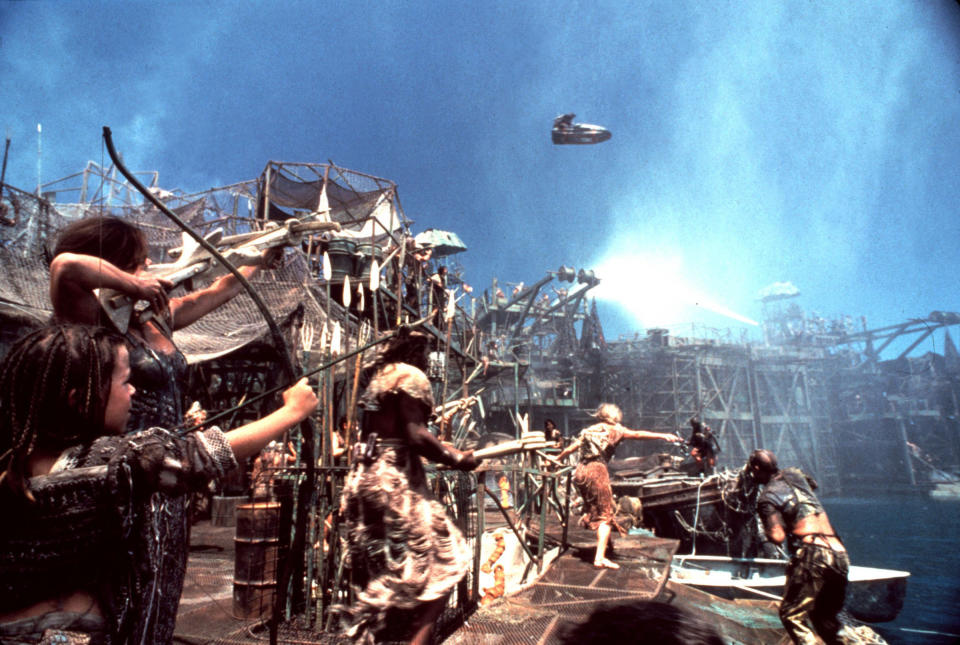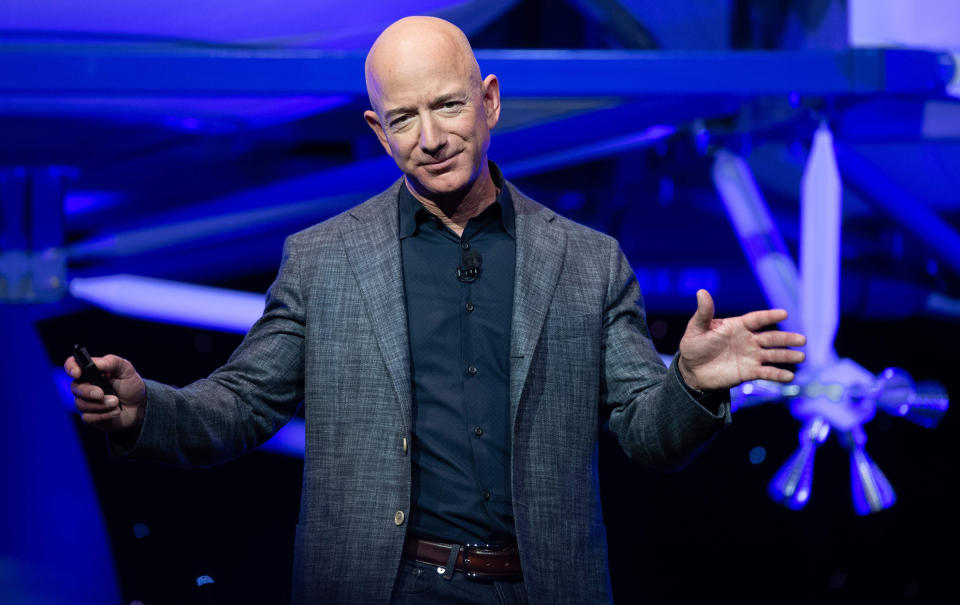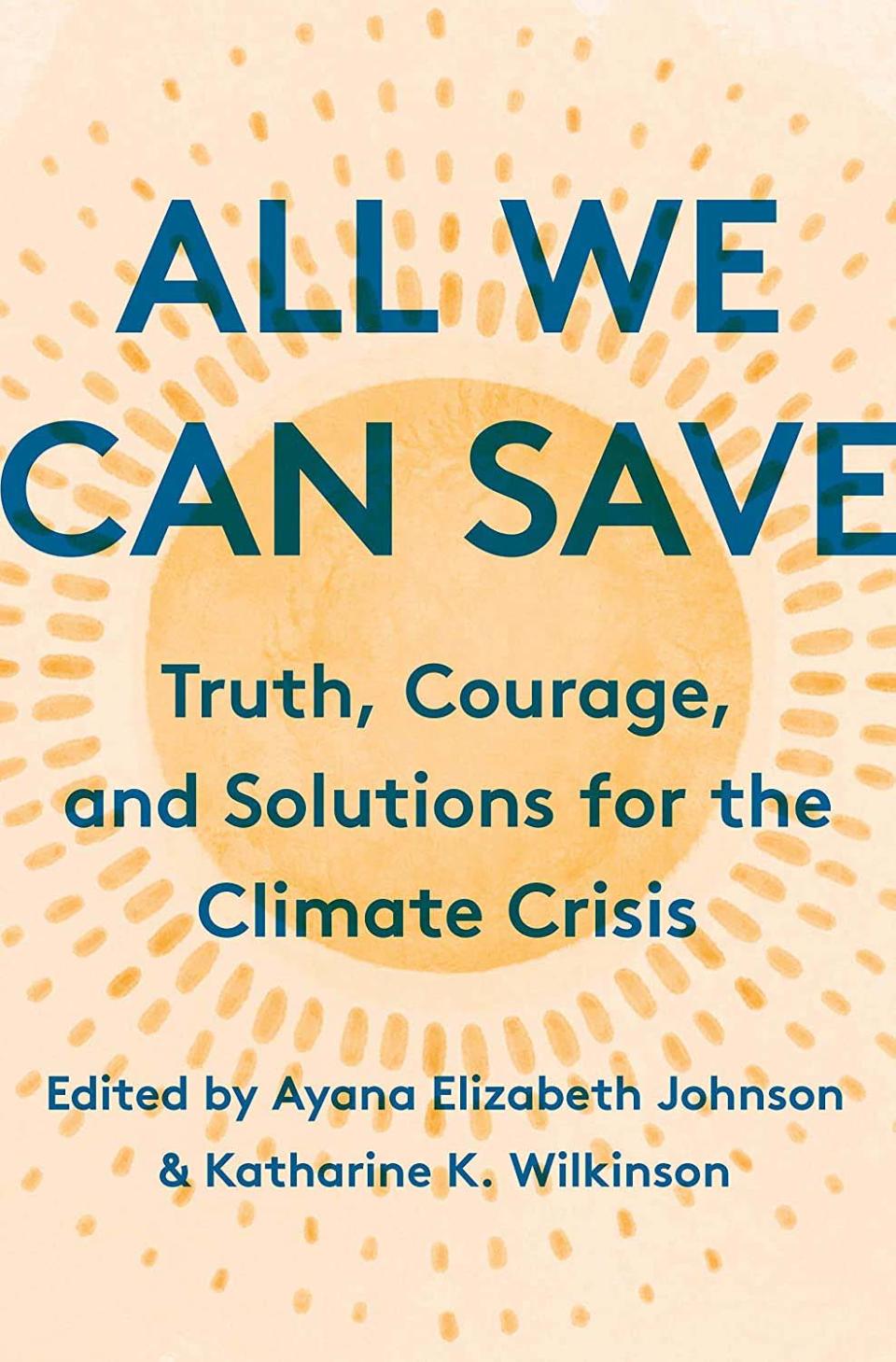'Wakanda Doesn't Have Suburbs': How Movies Like Black Panther Could Help Us Save the Planet

A view of Wakanda, in the movie 'Black Panther'. Credit - Walt Disney Studios Motion Pictures/Everett Collection
I don’t know when I first learned that the story of humanity was one of profound wrongness. But the idea that the world was broken because of our presence was always there, a constant cadence with which to orient my life, as seemingly natural as the four seasons that ordered my years and the cycle of the sun that ordered my days.
I grew up in the Catholic Church, whose theology of original sin means that humans are born with a built-in desire to disobey God ever since Eve, allegedly, took a bite of that damn apple. Since her and Adam’s punishment was to be kicked out of the Garden, it’s not a stretch to say that I also grew up with a belief that humans have an innate tendency to destroy their environment.
Growing up in New York City, secular classes taught to state standards imparted a similar message of humanity’s inherent shortcomings. A critical undercurrent of history and science classes, for example, is the idea of perpetual progress. That progress, we are taught, has always come at the cost of the environment—from smog-filled skies to landscapes devoid of birds, as chronicled in Rachel Carson’s Silent Spring. And, of course, the idea of progress itself implies that there is something wrong with the present and with our place in it.
I am not the only person who has gotten this message. Robin Wall Kimmerer, an enrolled member of the Citizen Potawatomi Nation, scientist, author, and lecturer, writes in her beautiful book Braiding Sweetgrass that in her survey of roughly two hundred third-year ecology students, almost all said that they thought that humans and nature were a bad mix. These were, she pointed out, people who had chosen to devote their lives to environmental protection. “I was stunned,” she wrote. “How is it possible that in twenty years of education that they cannot think of any beneficial relationships between people and the environment?”
When I share this quote with a friend, she points out that it is ahistorical to frame people and nature as always in opposition with each other. There are societies that live within their ecological boundaries. The mountainous nation of Bhutan, for example, absorbs more carbon than it emits. But good luck finding those stories in the tales that dominate much of U.S. culture.
Read More: 2020 Is Our Last, Best Chance to Save the Planet
As someone who consumes what I’m told is an excessive amount of popular culture, I can rattle off entire genres of film—from dystopian science fiction to horror movies to serious dramas—that reaffirm the idea that where humans go, ecological devastation inevitably follows.
Movies like Mad Max Beyond Thunderdome, Waterworld, and The Hunger Games—all of which, to be clear, I enjoyed—posit not only that humans could decimate the planet but that we will. Arguably my favorite dystopian movie, the 1986 Solarbabies, which features a glowing alien orb and kids roller-skating through the desert, is based on the idea that a global corporation would happily lock up every drop of water to turn the planet into a giant desert, and by proxy enslave humans, out of a desire for world domination. Reflect on that for a moment: The film’s central conceit is that lots of people think turning Earth into a hellscape is preferable to sharing resources.
James Cameron’s popular movie Avatar features a planet where intelligent beings live in concert with their environment until humans, once again, show up to destroy it. The short-lived television show Terra Nova deals with an overly polluted, overpopulated Earth by sending humans back in time to when dinosaurs roamed—before humans had a chance to spoil the place. The youth-oriented television network the CW has a show called The 100 in which the Earth is “simmering in radiation” as a result of a nuclear war. In the series opener, the surviving humans orbit the now-hazardous planet on spaceships. Space also features prominently in WALL-E, an animated film by Pixar that is ostensibly a story for children. It features not just a polluted Earth but an atmosphere so physically littered with trash that humans have opted to live on sterile space stations. Even Star Trek, which many hold up as a positive vision of humanity’s future, assumes that in order for us to live in equilibrium with our environment, we must first let key species, including whales, go extinct; fight a third world war; have a wiser, more advanced alien species intervene in our development; and create an off-planet resource base.
No big deal.

So disabused are we of the notion that humans en masse can have anything approaching the good life, that some of the most terrifying pieces of fiction aren’t ones in which the opening scenes are filled with horrors out of Dante’s Inferno but rather ones in which the setting is bucolic. In the television show The Good Place, demons torment the show’s protagonists by wielding a slightly twisted version of heaven. From Shirley Jackson’s short story “The Lottery” to Jordan Peele’s film Get Out, idyllic settings are increasingly a signal to the audience to prepare for some underlying wickedness. Of course, these are “only” stories. But stories are powerful.
A 2017 study in the journal Nature Communications found that among hunter-gatherer societies, those with better storytellers are more cooperative. It’s our ability to cooperate that anthropologists say has allowed humans to survive even the harshest environmental conditions and to fend off predators that could take us out individually. In fact, our brains are wired for story, which is why most of us can retain stories far longer than we can retain a series of facts stated plainly. The stories that we tell about ourselves and our place in the world are the raw materials from which we build our existence. Or, to borrow from the storyteller Kurt Vonnegut, “we are what we pretend to be, so we must be very careful what we pretend to be.”
Simon Lake, who helped pioneer the modern submarine, admits he was influenced by the idea of undersea exploration after reading Jules Verne’s Twenty Thousand Leagues Under the Sea. Physicist Leo Szilard, who helped develop the atomic bomb, was motivated in part by the H. G. Wells novel The World Set Free. The Star Trek communicator was the inspiration behind the cellphone.
Increasingly, the idea that the Earth will become unlivable due to human actions has created a push for us to move to a new frontier. It’s unclear if tech billionaires are taking cues from WALL-E, but some, such as Elon Musk and Jeff Bezos, are investing heavily in space exploration, their efforts predicated on the idea that humans need to move into space to survive as a species.
“We humans have to go to space if we are going to continue to have a thriving civilization,” Bezos told CBS Evening News in 2019, envisioning a world where we put big factories in space and zone the Earth as residential.
That humans would head out to space in order to mine it, by the way, is the framing of the television show The Expanse, which was saved from cancellation by Amazon, of which Bezos is founder and CEO. Like me, Bezos is on record as being a fan of the show.
Not everyone agrees with his must-go-to-space story, however.
“Fun fact: space wants you dead. Mars wants you dead. Titan wants you dead. Space will fucking kill you,” tweeted Shannon Stirone, a science writer whose work has appeared in The New York Times and The Atlantic.
“Earth is Easy Mode,” tweeted Mika McKinnon, a Canadian field geophysicist and science communicator, in agreement. “If we can’t maintain habitability here, we’re utterly fucked trying to pull off longterm survival anywhere else.”
And yet billions of dollars are being allocated to this effort. What does it say that spinning a story about humans moving into a radioactive vacuum resonates more strongly with many people than our chances of reducing greenhouse gas emissions?

Right now, the stories that many of us are telling about ourselves are hurting us.
It is not universal—there are cultures Indigenous to North America, for example, that are still enacting a different story—but this story of inherently destructive humans is the most mainstream. We need different stories, ones that help us envision a present in which humans live in concert with our environment. One in which we eat, play, move, and live in ways that are not just lighter on the Earth but also nurturing to us as humans, with at least some of the trappings that many of us have come to expect of modern life.
In fact, I can recall only one mainstream vision of the present— never mind the future—that starts from the premise that humans can live in equilibrium with their environment.
Our first glimpse of the fictional African country of Wakanda—the backdrop of the Marvel movie Black Panther, which is loosely based on the Mutapa Empire of 15th-century Zimbabwe—begins with the nation’s natural landscapes. Wakanda is the most technologically advanced country in the world, but the filmmakers choose to ground our understanding of this civilization in sweeping images of its mistveiled mountains; its verdant valleys, where sheepherders drive their flocks in ways they have likely done for generations; and its border tribesmen, wrapped in the Wakandan version of Lesotho blankets, galloping by on horseback. The message seems to be that Wakanda is a country whose greatest technological achievement is maintaining its environment.
From there, the camera takes us on an aerial tour of the capital city, Birnin Zana. The transition from lush countryside to bustling city is so abrupt, so fantastical, that it’s easy to miss what the camera is really telling us: that Wakanda can maintain its ecosystems in part because there are no suburbs.
It’s a vision of a modern civilization that looks and feels drastically different from the United States, where an estimated 52% of Americans describe their neighborhoods as suburban. Suburbs emerged in part because cities were polluted, with bad air quality and substandard housing. But rather than address those issues, we simply relocated our population and created new issues, not least among them an increased climate impact. Studies have shown that suburb dwellers have greater greenhouse gas emissions than their urban counterparts.
Black Panther’s vision of Wakanda rejects the oft-repeated story that we humans and our environment are natural enemies. Instead, it tells a story in which humans have become technologically sophisticated while maintaining a flourishing relationship with their surrounding environment.
To paint this picture, the filmmakers borrowed heavily from existing African cultures—the Maasai people of eastern Africa, the Zulu people of South Africa, the Sotho people of southern Africa, and the Himba tribes of Namibia, among others—and asked themselves: If these groups had not been colonized and had opted to live within their ecological limits, what would the resultant society look like? And to them, it looked like an urban core surrounded by countryside before giving way to true wildlands.
In Birnin Zana the skyscrapers, as envisioned by director Ryan Coogler, are high, organic structures that rise out of surrounding forests so lush they have likely never been chopped down. And many of the buildings have plants growing off terraces and rooftops. On the ground, a trolley toddles through the city, kicking up some dust because the ground is not asphalt but rather pressed earth. It moves fast enough to beat walking but slowly enough that people instinctively move out of its way, mingling through a narrow (by North American standards) streetscape that contains no sidewalk—evoking the famed words of the sociologist Lewis Mumford, “Forget the damned motor car and build cities for lovers and friends.” Wakanda doesn’t have cars, and thus its streets have no need for separation.
All of this means that even without vibranium, the fictional metal that powers Wakanda’s technology, the country would be more sustainable than the United States. Cities that have more green space are naturally cooler, requiring less air-conditioning, lowering energy use and making it easier to reduce fossil fuel use and rely on renewable energy. They also reduce the likelihood of minor flooding because, unlike cement or concrete hardscaping, soil absorbs water instead of having it run off. Green spaces also provide a host of psychosocial benefits, from improving mood and behavior to speeding up healing and increasing students’ ability to learn.

Eliminating suburbs and their longer-distance counterpart, exurbs, could be one way of slashing the country’s ecological footprint. No suburbs mean fewer roads to fragment ecosystems, making it easier for animals and plants to survive, promoting biodiversity. Roads also use a lot of cement, which is a major source of greenhouse gas emissions, as well as sand, which is often acquired by dredging rivers and other critical ecosystems. These impacts happen regardless of whether or not the vehicle in question runs on gas, electricity, or the hopes and dreams of future generations. It’s the whole structure of suburban life and car dependence that’s the problem.
At the same time, it’s not clear that suburban living, which is associated with increased social isolation, especially for those with longer commutes, is any good for humans. At least one study, of couples in Sweden, found that those where at least one partner has a commute forty-five minutes or longer are 40% more likely to divorce. Suburban residents are less likely to get physical exercise than their urban counterparts.
Beyond its fantastical elements—superpowers and impossibly high tech—Black Panther is telling a very different story of what it means to be human. And even when trouble comes, it comes in the form of an angry outsider named Killmonger, who is telling a flawed story based on conquest and scarcity—a very U.S. story—of what it means to be human. Wakandans elected to tell a story about themselves that differs from Killmonger’s—namely that it was possible to improve the quality of their lives without degrading the environment that they depend on—and then they did it.
And yet when we talk about climate change, there’s often a hidden resignation—like, of course we harmed the Earth. And when we talk about acting on it, there’s also an undercurrent: that it will require a level of sacrifice that is worth it, but just barely. What if, instead, the story we tell about climate change is that it is an opportunity? One for humans to repair our relationship with the Earth and re-envision our societies in ways that are not just in keeping with our ecosystems but also make our lives better?
If this doesn’t sound possible, ask yourself: Why not?
Maybe we should start telling ourselves a different story. One that is a bit more like Wakanda. One that maybe goes something like this…
Once upon a time, some humans told a story about their relationship to the Earth, and they used it to build a world that was beautiful but flawed. Over time, people realized that was the wrong story and they constructed a new one, one that said they could live in harmony with their environment. And they used the pieces of their old story to help construct their new one.
“Wakanda Doesn’t Have Suburbs” by Kendra Pierre-Louis is from the book ALL WE CAN SAVE: Truth, Courage, and Solutions for the Climate Crises edited by Ayana Elizabeth Johnson and Katharine K. Wilkinson. Copyright © 2020 by Ayana Elizabeth Johnson and Katharine K. Wilkinson. Published by One World, an imprint of Random House, a division of Penguin Random House LLC. Buy the book here.

 Yahoo Finance
Yahoo Finance 